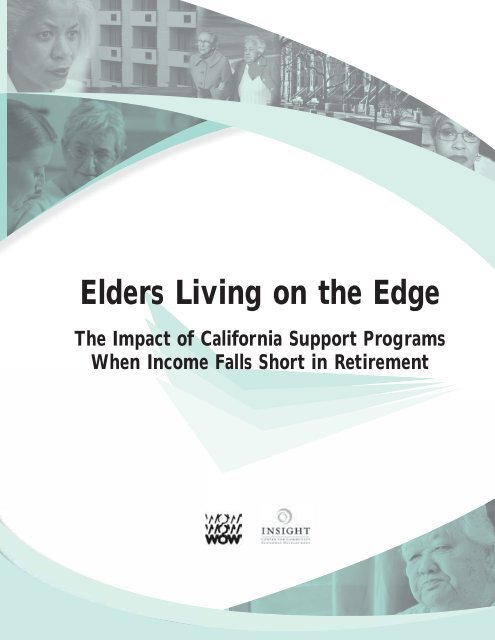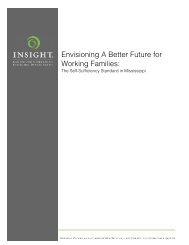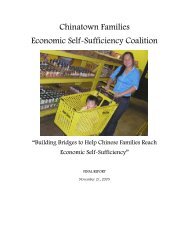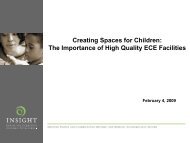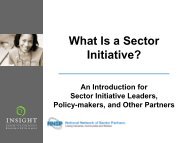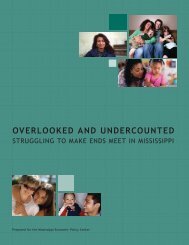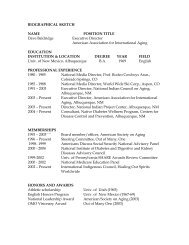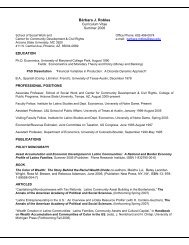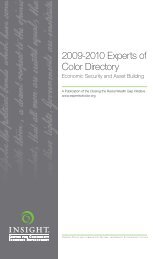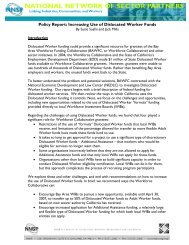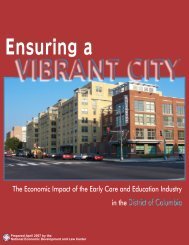Elders Living on the Edge - Insight Center for Community Economic ...
Elders Living on the Edge - Insight Center for Community Economic ...
Elders Living on the Edge - Insight Center for Community Economic ...
You also want an ePaper? Increase the reach of your titles
YUMPU automatically turns print PDFs into web optimized ePapers that Google loves.
<str<strong>on</strong>g>Elders</str<strong>on</strong>g> <str<strong>on</strong>g>Living</str<strong>on</strong>g> <strong>on</strong> <strong>the</strong> <strong>Edge</strong><br />
The Impact of Cali<strong>for</strong>nia Support Programs<br />
When Income Falls Short in Retirement
<str<strong>on</strong>g>Elders</str<strong>on</strong>g> <str<strong>on</strong>g>Living</str<strong>on</strong>g> <strong>on</strong> <strong>the</strong> <strong>Edge</strong><br />
The Impact of Cali<strong>for</strong>nia Support Programs<br />
When Income Falls Short in Retirement<br />
Wider Opportunities <strong>for</strong> Women<br />
February 2008<br />
Prepared <strong>for</strong> <strong>the</strong> Cali<strong>for</strong>nia Elder Ec<strong>on</strong>omic Security Initiative (Cal-EESI),<br />
a project led by <strong>the</strong> <strong>Insight</strong> <strong>Center</strong> <strong>for</strong> <strong>Community</strong> Ec<strong>on</strong>omic Development<br />
(<strong>for</strong>merly NEDLC), in partnership with Wider Opportunities <strong>for</strong> Women (WOW).
The Cali<strong>for</strong>nia Elder Ec<strong>on</strong>omic Security Initiative<br />
Led by <strong>the</strong> <strong>Insight</strong> <strong>Center</strong> <strong>for</strong> <strong>Community</strong> Ec<strong>on</strong>omic Development (<strong>for</strong>merly<br />
NEDLC), in coordinati<strong>on</strong> with <strong>the</strong> nati<strong>on</strong>ally led ef<strong>for</strong>t by Wider Opportunities<br />
<strong>for</strong> Women (WOW), <strong>the</strong> Cali<strong>for</strong>nia Elder Ec<strong>on</strong>omic Security Initiative (Cal-EESI)<br />
program is a statewide, research-driven initiative at <strong>the</strong> <strong>for</strong>efr<strong>on</strong>t of a nati<strong>on</strong>al<br />
ef<strong>for</strong>t to raise awareness and promote policy change to ensure that older Americans can live with<br />
dignity and ec<strong>on</strong>omic well-being in <strong>the</strong>ir own homes. Using <strong>the</strong> Elder Standard Index, Cal-EESI provides<br />
educati<strong>on</strong>, advocacy and outreach to policymakers, advocates, foundati<strong>on</strong>s and direct service providers.<br />
The Elder Standard Index <strong>for</strong> Cali<strong>for</strong>nia was tabulated by UCLA’s <strong>Center</strong> <strong>for</strong> Health Policy Research<br />
using <strong>the</strong> nati<strong>on</strong>al methodology developed by WOW and The Ger<strong>on</strong>tology Institute at <strong>the</strong> University of<br />
Massachusetts Bost<strong>on</strong>.<br />
Cal-EESI is powered by a broad-based coaliti<strong>on</strong> of organizati<strong>on</strong>s dedicated to ensuring <strong>the</strong> well-being<br />
of elders and <strong>the</strong>ir families in Cali<strong>for</strong>nia including policymakers, advocates, researchers, direct service<br />
providers and public agencies, seniors, n<strong>on</strong>-profits, grant-makers, and senior membership organizati<strong>on</strong>s.<br />
A statewide steering committee guides <strong>the</strong> overall directi<strong>on</strong> of <strong>the</strong> initiative and identifies policy<br />
priorities—drawn from <strong>the</strong> Elder Standard Index data—to help close <strong>the</strong> gap between elders’ income<br />
and <strong>the</strong>ir rising cost of living in Cali<strong>for</strong>nia. Local steering committees across Cali<strong>for</strong>nia use <strong>the</strong> Elder<br />
Standard Index data to educate local leaders and improve programs and policies <strong>for</strong> older adults. All<br />
coaliti<strong>on</strong> members are empowered to roll out and instituti<strong>on</strong>alize <strong>the</strong> Elder Standard Index in <strong>the</strong>ir own<br />
communities as <strong>the</strong>y see fit. For more in<strong>for</strong>mati<strong>on</strong> <strong>on</strong> Cal-EESI or <strong>the</strong> Elder Standard Index, c<strong>on</strong>tact<br />
Susie Smith by ph<strong>on</strong>e 510.251.2600 x108 or e-mail at ssmith@insightcced.org.<br />
Wider Opportunities <strong>for</strong> Women (WOW)<br />
WOW works nati<strong>on</strong>ally and in its home community of Washingt<strong>on</strong>, DC to<br />
achieve ec<strong>on</strong>omic independence and equality of opportunity <strong>for</strong> women and<br />
girls at all stages of life. For over 40 years, WOW has been a leader in <strong>the</strong> areas<br />
of n<strong>on</strong>traditi<strong>on</strong>al employment, job training and educati<strong>on</strong>, welfare to work and<br />
work<strong>for</strong>ce development policy. Since 1995, WOW has been devoted to <strong>the</strong> selfsufficiency<br />
of women and <strong>the</strong>ir families through <strong>the</strong> nati<strong>on</strong>al Family Ec<strong>on</strong>omic Self-Sufficiency project<br />
(FESS). Through FESS, WOW has reframed <strong>the</strong> nati<strong>on</strong>al debate <strong>on</strong> social policies and programs from <strong>on</strong>e<br />
that focuses <strong>on</strong> poverty to <strong>on</strong>e that focuses <strong>on</strong> what it takes families to make ends meet. Building <strong>on</strong><br />
FESS, WOW has expanded to meet its intergenerati<strong>on</strong>al missi<strong>on</strong> of ec<strong>on</strong>omic independence <strong>for</strong> women<br />
at all stages of life with EESI. For more in<strong>for</strong>mati<strong>on</strong> about WOW’s programs go to www.wow<strong>on</strong>line.org<br />
or call WOW at 202-464-1596.<br />
The authors, of course, are resp<strong>on</strong>sible <strong>for</strong> <strong>the</strong> c<strong>on</strong>tents of this report, and accept resp<strong>on</strong>sibility <strong>for</strong> any<br />
errors or omissi<strong>on</strong>s.<br />
<str<strong>on</strong>g>Elders</str<strong>on</strong>g> <str<strong>on</strong>g>Living</str<strong>on</strong>g> <strong>on</strong> <strong>the</strong> <strong>Edge</strong>:<br />
The Impact of Cali<strong>for</strong>nia Support Programs When Income Falls Short in Retirement<br />
© February 2008, Wider Opportunities <strong>for</strong> Women<br />
ii • <str<strong>on</strong>g>Elders</str<strong>on</strong>g> <str<strong>on</strong>g>Living</str<strong>on</strong>g> <strong>on</strong> <strong>the</strong> <strong>Edge</strong>
<str<strong>on</strong>g>Elders</str<strong>on</strong>g> <str<strong>on</strong>g>Living</str<strong>on</strong>g> <strong>on</strong> <strong>the</strong> <strong>Edge</strong><br />
The Impact of Cali<strong>for</strong>nia Support Programs<br />
When Income Falls Short in Retirement<br />
It is increasingly difficult <strong>for</strong> older Americans to live with dignity and ec<strong>on</strong>omic well-being in <strong>the</strong>ir<br />
own homes. This is particularly true in Cali<strong>for</strong>nia, where <strong>the</strong> actual cost of living far exceeds traditi<strong>on</strong>al<br />
measures of income sufficiency. Cali<strong>for</strong>nian low-income elders face financial challenges that threaten<br />
<strong>the</strong>ir already fragile ec<strong>on</strong>omic stability and <strong>the</strong> health of <strong>the</strong>ir communities. On <strong>on</strong>e side, <strong>the</strong>y are pressured<br />
by ever-increasing expenses—housing, health care, fuel and utilities. On <strong>the</strong> o<strong>the</strong>r, <strong>the</strong>y see <strong>the</strong>ir<br />
fixed incomes eroded by Social Security payments and Supplemental Security Income that do not keep<br />
pace with <strong>the</strong> rapidly rising costs of basic needs, underfunding of public support programs, and asset<br />
limits that prevent those receiving public supports from saving <strong>for</strong> <strong>the</strong>ir retirement. Cali<strong>for</strong>nia elders are<br />
between <strong>the</strong> proverbial rock and a hard place.<br />
How Much Income Is Needed by Our<br />
Growing Populati<strong>on</strong> of Older Adults to<br />
Cover Today’s Rising Costs of <str<strong>on</strong>g>Living</str<strong>on</strong>g>?<br />
What is <strong>the</strong> true impact of public programs,<br />
such as Medi-Cal, utility assistance, or housing<br />
assistance <strong>on</strong> an elder’s income, housing and<br />
health care expenses? To accurately answer <strong>the</strong>se<br />
questi<strong>on</strong>s, policymakers, advocates and social<br />
service providers require an accurate measure of<br />
ec<strong>on</strong>omic security <strong>for</strong> elders. The Nati<strong>on</strong>al Elder<br />
Ec<strong>on</strong>omic Security Initiative program, a multiyear,<br />
research-driven initiative to raise awareness<br />
and promote policy change <strong>for</strong> older adults, offers<br />
such a benchmark—<strong>the</strong> Elder Ec<strong>on</strong>omic Security<br />
Standard Index (“<strong>the</strong> Index”). This new Index<br />
measures what adults 65 and older require to<br />
make ends meet and remain in <strong>the</strong>ir own homes.<br />
Using this Index, <strong>the</strong> Elder Ec<strong>on</strong>omic Security<br />
Initiative works to ensure that ultimately all older<br />
adults can live with dignity, independence, and<br />
ec<strong>on</strong>omic well-being.<br />
This brief illustrates how a selected group of public<br />
supports can help seniors achieve ec<strong>on</strong>omic security<br />
as defined by <strong>the</strong> new Index. The Index allows<br />
us to:<br />
• examine <strong>the</strong> compositi<strong>on</strong>s of <strong>the</strong> average<br />
elder’s costs of basic needs<br />
• measure <strong>the</strong> gaps between income and ec<strong>on</strong>omic<br />
security;<br />
• determine how well public supports can help<br />
fill those gaps; and<br />
• benchmark an elder’s progress toward achieving<br />
ec<strong>on</strong>omic security.<br />
The Impact of Cali<strong>for</strong>nia Support Programs When Income Falls Short in Retirement • 1
Above Average Income But Still<br />
Falling Short of Ec<strong>on</strong>omic Security<br />
Even elders whose incomes are above <strong>the</strong> average<br />
retirement income <strong>for</strong> <strong>the</strong>ir counties often<br />
fall short of ec<strong>on</strong>omic security as measured by<br />
<strong>the</strong> Index (see Figure 1). This is true not <strong>on</strong>ly<br />
<strong>for</strong> those elders entirely dependent <strong>on</strong> Social<br />
Security, but also <strong>for</strong> those whose incomes<br />
include retirement accounts, private savings,<br />
and pensi<strong>on</strong>s. Single women with <strong>the</strong> average<br />
woman’s retirement income find <strong>the</strong>mselves more<br />
than $3,000 below <strong>the</strong> ec<strong>on</strong>omic security threshold<br />
in low-cost counties, and more than $10,000<br />
below <strong>the</strong> Index in high-cost counties. Even at<br />
incomes above $20,000, nearly double <strong>the</strong> federal<br />
poverty line (FPL), elders who rent in high-cost<br />
counties comm<strong>on</strong>ly lack <strong>the</strong> income required to<br />
make ends meet.<br />
Housing Costs Threaten<br />
Ec<strong>on</strong>omic Security, But Housing<br />
Assistance Can Close <strong>the</strong> Gap<br />
Across all counties in Cali<strong>for</strong>nia, elders experience<br />
significant housing expenses regardless of homeownership<br />
or rental status. A typical elder may<br />
pay four times as much <strong>for</strong> housing depending<br />
<strong>on</strong> where he or she lives and whe<strong>the</strong>r or not he or<br />
she rents, has paid off a mortgage, or is still paying<br />
off a mortgage.<br />
In high-cost counties such as <strong>the</strong> San Francisco<br />
Bay Area and Los Angeles, housing costs <strong>for</strong> renters<br />
comprise more than 50% of <strong>the</strong> Index total<br />
expenses (see Figure 2), and housing costs <strong>for</strong><br />
homeowners with mortgages comprise as much<br />
as 70% of <strong>the</strong> Index expenses.<br />
Figure 1: Elder Ec<strong>on</strong>omic Security Standard Index <strong>for</strong> Single <str<strong>on</strong>g>Elders</str<strong>on</strong>g>:<br />
Cali<strong>for</strong>nia <str<strong>on</strong>g>Elders</str<strong>on</strong>g> Can’t Make Ends Meet<br />
What It Takes to Live<br />
$30,224 (Homeowner w/Mortgage Index)<br />
$20,011 (Renter Index)<br />
$17,105 (Homeowner w/o Mortgage Index)<br />
$10,210 (Federal Poverty Level)<br />
$10,272<br />
CA Supplemental<br />
Security Income (SSI)<br />
Standard<br />
$12,569<br />
CA Average Annual<br />
Social Security<br />
<strong>for</strong> Retirees<br />
$16,172<br />
CA Median Elder<br />
Retirement Income*<br />
Elder Ec<strong>on</strong>omic Security Standard Indexes and Benchmark Annual Incomes <strong>for</strong><br />
single elders in Cali<strong>for</strong>nia, 2007. The Elder Ec<strong>on</strong>omic Security Standard Index <strong>for</strong> Cali<strong>for</strong>nia was<br />
tabulated by UCLA’s <strong>Center</strong> <strong>for</strong> Health Policy Research using <strong>the</strong> nati<strong>on</strong>al methodology developed by<br />
WOW and The Ger<strong>on</strong>tology Institute at <strong>the</strong> University of Massachusetts Bost<strong>on</strong>.<br />
* The Index assumes full retirement <strong>for</strong> elders. Median elder retirement income includes all pers<strong>on</strong>al income <strong>for</strong> elders 65(+) who lack earned income.<br />
2 • <str<strong>on</strong>g>Elders</str<strong>on</strong>g> <str<strong>on</strong>g>Living</str<strong>on</strong>g> <strong>on</strong> <strong>the</strong> <strong>Edge</strong>
Figure 2:<br />
Housing Expenses Can Comprise<br />
Over Half of an Elder’s Budget<br />
Housing<br />
Food<br />
Transport<br />
Health<br />
Misc.<br />
Health Care<br />
(Good Health)<br />
10%<br />
Miscellaneous<br />
12%<br />
Housing<br />
53%<br />
Helping <str<strong>on</strong>g>Elders</str<strong>on</strong>g> Close <strong>the</strong><br />
Gap: Income Supports<br />
Once <strong>the</strong> gap between income and ec<strong>on</strong>omic<br />
security has been measured, <strong>the</strong> questi<strong>on</strong> to be<br />
asked and answered by policy makers, service<br />
providers, potential support recipients, and c<strong>on</strong>cerned<br />
citizens is clear: If you d<strong>on</strong>’t have enough<br />
retirement income to meet your basic needs, what<br />
supports can help? This brief examines <strong>the</strong> impact<br />
of income supports that can assist elders in closing<br />
<strong>the</strong> gap.<br />
Transportati<strong>on</strong><br />
11%<br />
Food<br />
14%<br />
Elder Ec<strong>on</strong>omic Security Standard Index<br />
expenses <strong>for</strong> a single elder renter in <strong>the</strong> City of<br />
Los Angeles, 2007. The Elder Ec<strong>on</strong>omic Security<br />
Standard Index <strong>for</strong> Cali<strong>for</strong>nia was tabulated by<br />
UCLA’s <strong>Center</strong> <strong>for</strong> Health Policy Research using<br />
<strong>the</strong> nati<strong>on</strong>al methodology developed by WOW<br />
and The Ger<strong>on</strong>tology Institute at <strong>the</strong> University<br />
of Massachusetts Bost<strong>on</strong>.<br />
Without housing assistance, renters across a spectrum<br />
of incomes fall well below <strong>the</strong> Index—but<br />
with geography-based housing assistance and<br />
o<strong>the</strong>r supports, nearly all low-income renters<br />
can come within 5% of attaining <strong>the</strong>ir counties’<br />
Indexes—including elders living below <strong>the</strong> 2007<br />
federal poverty level of $10,210. In low-cost<br />
counties, housing assistance can help close <strong>the</strong><br />
income gap by 18% (see Figure 3); in high-cost<br />
counties housing assistance may help close <strong>the</strong><br />
gap by more than 30%.<br />
Low-income renters in low-cost counties who<br />
d<strong>on</strong>’t receive housing assistance will <strong>on</strong>ly come<br />
close to ec<strong>on</strong>omic security if <strong>the</strong>y receive a variety<br />
of o<strong>the</strong>r supports.<br />
Nutriti<strong>on</strong> Assistance—Food Stamps<br />
Administered by <strong>the</strong> U.S. Department of<br />
Agriculture, <strong>the</strong> Food Stamp Program provides<br />
low-income households with coup<strong>on</strong>s or electr<strong>on</strong>ic<br />
benefits to purchase food. For single elders<br />
Figure 3: All Supports Are Essential,<br />
But Only Housing Assistance Can<br />
Guarantee Ec<strong>on</strong>omic Security<br />
Income<br />
Food Stamps<br />
LIS<br />
Medi-Cal<br />
HEAP<br />
Housing<br />
Assistance<br />
Medi-Cal<br />
15%<br />
HEAP<br />
1%<br />
LIS 3%<br />
Food Stamps<br />
1%<br />
Housing<br />
Assistance<br />
18%<br />
Income<br />
62%<br />
Income and supports as a percentage of <strong>the</strong><br />
Elder Standard Index <strong>for</strong> a single elder renter<br />
living <strong>on</strong> average annual Social Security<br />
in Fresno County, CA, 2007.<br />
The Impact of Cali<strong>for</strong>nia Support Programs When Income Falls Short in Retirement • 3
to be eligible, “net” m<strong>on</strong>thly income must be<br />
no more than 100% FPL (or $10,210 annually)<br />
after deducti<strong>on</strong>s <strong>for</strong> earned income, child care,<br />
medical expenses, a porti<strong>on</strong> of some shelter<br />
costs and o<strong>the</strong>r expenses. Assets cannot<br />
exceed $3,000. The average amount of Food<br />
Stamps benefits received per Cali<strong>for</strong>nia household<br />
in 2005 was $242 per m<strong>on</strong>th, but single retired<br />
elders, who lack earned income and dependent<br />
children, comm<strong>on</strong>ly just receive $10 per m<strong>on</strong>th.<br />
Prescripti<strong>on</strong> Assistance—Medicare<br />
Part D Low-Income Subsidy (LIS)<br />
The Low-Income Subsidy helps elders with<br />
prescripti<strong>on</strong> drug costs. The Social Security<br />
Administrati<strong>on</strong> and local Medi-Cal offices administer<br />
<strong>the</strong> program. The federal government pays<br />
subsidies to <strong>the</strong> participant’s chosen Medicare Part<br />
D insurance plan, helping pay premiums, deductibles<br />
and co-payments. Those with Medicare and<br />
Medi-Cal, or those participating in <strong>the</strong> Medical<br />
Savings Programs automatically qualify <strong>for</strong> LIS. For<br />
single elders to be eligible <strong>for</strong> full LIS, <strong>the</strong>ir<br />
income cannot exceed 100% FPL. <str<strong>on</strong>g>Elders</str<strong>on</strong>g> with<br />
income between 100% FPL and 150% FPL<br />
(or $15,315 annually) are eligible <strong>for</strong> LIS <strong>on</strong><br />
a sliding scale of coverage. <str<strong>on</strong>g>Elders</str<strong>on</strong>g> must also<br />
maintain less than $7,620 in assets.<br />
Health Care Assistance—Medi-Cal<br />
Medi-Cal is Cali<strong>for</strong>nia’s Medicaid program, a public<br />
health insurance program serving low-income<br />
families with children, seniors, pers<strong>on</strong>s with disabilities,<br />
and o<strong>the</strong>rs. Medi-Cal pays <strong>for</strong> nearly<br />
all “medically necessary” health care, adult day<br />
health services, home health care, some prescripti<strong>on</strong><br />
drugs excluded by Part D, dental care, and<br />
some medical equipment. Medi-Cal also covers<br />
Medicare Part B premiums and Part A and B<br />
deductibles and co-payments. For single elders<br />
to be eligible <strong>for</strong> Medi-Cal, countable income<br />
cannot exceed 127% FPL (or $12,972 annually).<br />
Assets cannot exceed $2,000. Those<br />
65 years old or older who receive Supplemental<br />
Security Income/State Supplementary Payment<br />
(SSI/SSP) are automatically eligible <strong>for</strong> Medi-Cal.<br />
Utility Assistance—LIHEAP<br />
The Low Income Home Energy Assistance<br />
Program (LIHEAP) assists low-income households<br />
that spend a high proporti<strong>on</strong> of household income<br />
<strong>on</strong> energy, primarily cooling and heating. The<br />
U.S. Department of Health and Human Services<br />
allocates LIHEAP funding to <strong>the</strong> Department<br />
of <strong>Community</strong> Services & Development, which<br />
distributes funds to community providers, which<br />
make direct payments to utilities <strong>on</strong> recipients’<br />
behalves. Assistance is based <strong>on</strong> income, household<br />
size and <strong>the</strong> cost of utilities within each<br />
county. For elders to be eligible <strong>for</strong> HEAP,<br />
<strong>the</strong>ir income cannot exceed 60% of state<br />
median income or 130% FPL (or $13,237<br />
annually). Funding is fixed annually, and distributed<br />
am<strong>on</strong>g all applicants; <strong>the</strong> greater <strong>the</strong><br />
number of applicants, <strong>the</strong> smaller <strong>the</strong> payment<br />
to each recipient. In 2006, <strong>the</strong> average annual<br />
assistance in Cali<strong>for</strong>nia <strong>for</strong> homes using gas and<br />
electric was $275.<br />
Housing Assistance<br />
Eligible elders can receive direct or implicit housing<br />
subsidies from 3 programs funded by <strong>the</strong> U.S.<br />
Department of Housing and Urban Development<br />
(HUD): <strong>the</strong> Housing Choice Voucher Program (a<br />
part of Secti<strong>on</strong> 8), Public Housing, and <strong>the</strong> Secti<strong>on</strong><br />
202 Supportive Housing <strong>for</strong> <strong>the</strong> Elderly Program.<br />
Recipients of a Secti<strong>on</strong> 8 voucher may select any<br />
housing, and voucher amounts are based <strong>on</strong> a local<br />
“fair market rent” established by HUD. Secti<strong>on</strong> 202<br />
provides capital and operating funds to n<strong>on</strong>profit<br />
organizati<strong>on</strong>s that develop and operate senior<br />
housing including <strong>the</strong> c<strong>on</strong>structi<strong>on</strong> of housing.<br />
4 • <str<strong>on</strong>g>Elders</str<strong>on</strong>g> <str<strong>on</strong>g>Living</str<strong>on</strong>g> <strong>on</strong> <strong>the</strong> <strong>Edge</strong>
Housing assistance recipients generally have<br />
incomes less than 50% of area median income<br />
(in Los Angeles this would translate to 254%<br />
FPL or $25,900 annually). If eligible <strong>for</strong> priority<br />
assistance status, <strong>the</strong> recipient’s income<br />
must be less than 30% of area median income<br />
(in Los Angeles this would translate to 152%<br />
FPL or $15,550 annually).<br />
Supplemental Security Income (SSI)<br />
Administered by <strong>the</strong> Social Security Administrati<strong>on</strong>,<br />
SSI provides m<strong>on</strong>thly cash payments to people in<br />
need. SSI is <strong>for</strong> people who are 65 or older, blind or<br />
disabled. The state of Cali<strong>for</strong>nia supplements <strong>the</strong><br />
federal payment. To qualify an elder must have<br />
countable income less than $10,272 (or 105%<br />
FPL), and few assets o<strong>the</strong>r than a home and<br />
<strong>on</strong>e car. In order to receive SSI, an elder also must<br />
apply <strong>for</strong> any o<strong>the</strong>r income supports <strong>the</strong>y may be<br />
able to get.<br />
Each of <strong>the</strong>se programs, as well as <strong>the</strong><br />
Medicare Savings Program, can individually<br />
help move elders closer to achieving ec<strong>on</strong>omic<br />
security, but <strong>on</strong>ly <strong>the</strong> full package of income<br />
supports including often unattainable housing<br />
assistance will guarantee ec<strong>on</strong>omic security.<br />
Barriers to Securing Support<br />
Many seniors desperately in need of supports<br />
often find <strong>the</strong>ir Social Security income provides<br />
<strong>the</strong>m too little income to be ec<strong>on</strong>omically secure<br />
but too much income to meet <strong>the</strong> various income<br />
eligibility guidelines of <strong>the</strong> support programs. Even<br />
more challenging are programs’ varied income<br />
eligibility guidelines <strong>for</strong> programs. Many elders<br />
find <strong>the</strong> range, from 100% FPL to 254% FPL,<br />
c<strong>on</strong>fusing, and <strong>the</strong>re<strong>for</strong>e are unsure about<br />
<strong>the</strong>ir eligibility.<br />
<str<strong>on</strong>g>Elders</str<strong>on</strong>g> face o<strong>the</strong>r barriers to enrollment in government<br />
supports including <strong>the</strong> burdensome<br />
applicati<strong>on</strong> process, cultural and language barriers,<br />
exceedingly low asset limits, and <strong>the</strong> stigma<br />
of “welfare.” Enrollment in programs of this nature<br />
could save an elder hundreds of dollars a m<strong>on</strong>th.<br />
The limited nature of assistance also prevents<br />
elders from gaining help. For instance, due to<br />
already insufficient public housing, Secti<strong>on</strong> 8, and<br />
Secti<strong>on</strong> 202 housing, housing assistance is hard<br />
to come by in Cali<strong>for</strong>nia. Vouchers are limited in<br />
number and little public housing has been built<br />
since <strong>the</strong> early 1980s. A survey recently c<strong>on</strong>ducted<br />
by <strong>the</strong> Housing Authority Associati<strong>on</strong> of<br />
Sou<strong>the</strong>rn Cali<strong>for</strong>nia and <strong>the</strong> Nor<strong>the</strong>rn Cali<strong>for</strong>nia/<br />
Nevada Executive Directors Associati<strong>on</strong> reports<br />
<strong>the</strong> Housing Choice Voucher Program waiting<br />
list hovers around 597,890 individuals and <strong>the</strong><br />
Public Housing waiting list includes 319,892<br />
individuals. This number will <strong>on</strong>ly increase <strong>on</strong>ce<br />
<strong>the</strong> few outstanding Housing Authorities submit<br />
reports. The Housing Authority Associati<strong>on</strong> of<br />
Sou<strong>the</strong>rn Cali<strong>for</strong>nia and <strong>the</strong> Nor<strong>the</strong>rn Cali<strong>for</strong>nia/<br />
Nevada Executive Directors Associati<strong>on</strong> collected<br />
this data while working jointly <strong>on</strong> <strong>the</strong> 2008<br />
Legislative Focus. With demand far exceeding supply,<br />
and <strong>on</strong>ly a small percentage of eligible applicants<br />
receive assistance; <strong>the</strong> majority of applicants,<br />
especially in Cali<strong>for</strong>nia, languish <strong>on</strong> waiting lists.<br />
Not Eligible <strong>for</strong> Help Nor<br />
Ec<strong>on</strong>omically Secure<br />
Programs with low income eligibility based <strong>on</strong><br />
<strong>the</strong> FPL are ignoring <strong>the</strong> majority of elders living<br />
<strong>on</strong> incomes above <strong>the</strong> FPL but below what <strong>the</strong>y<br />
need to make ends meet. Of <strong>the</strong> 25 most populous<br />
Cali<strong>for</strong>nia counties, 20 counties have Indexes<br />
that are 200% FPL or greater, and <strong>the</strong> average<br />
of all county Indexes <strong>for</strong> <strong>the</strong> state of Cali<strong>for</strong>nia is<br />
$22,709—222% FPL.<br />
Low-income single elders with incomes between<br />
approximately $13,500 (about 130% FPL) and<br />
The Impact of Cali<strong>for</strong>nia Support Programs When Income Falls Short in Retirement • 5
$16,000 (about 155% FPL) are <strong>the</strong> most vulnerable,<br />
even if <strong>the</strong>y receive housing assistance.<br />
Without housing assistance, <strong>the</strong> Index dem<strong>on</strong>strates<br />
that such elders are unlikely to meet more<br />
than 70% of <strong>the</strong>ir ec<strong>on</strong>omic needs.<br />
Policy Recommendati<strong>on</strong>s<br />
In <strong>the</strong> face of today’s high and rising living costs,<br />
<strong>the</strong>re must be a c<strong>on</strong>tinuum of access to programs<br />
that help elders when <strong>the</strong>ir incomes fall<br />
short of <strong>the</strong> basic costs of living in Cali<strong>for</strong>nia’s<br />
communities. Expanded access to programs will<br />
require changes, outreach, and funding—at both<br />
<strong>the</strong> federal and state levels—to ensure that elders<br />
maintain a roof over <strong>the</strong>ir heads, food <strong>on</strong> <strong>the</strong>ir<br />
table, and prescripti<strong>on</strong>s needed to manage health<br />
c<strong>on</strong>diti<strong>on</strong>s as <strong>the</strong>y age. To ensure ec<strong>on</strong>omic security<br />
<strong>for</strong> all elders, we must:<br />
1. Defend Retirement Income. Erosi<strong>on</strong> of <strong>the</strong><br />
progress that has been made <strong>on</strong> behalf of<br />
elder ec<strong>on</strong>omic security must be reversed by<br />
supporting and streng<strong>the</strong>ning Social Security,<br />
expanding (or providing) worker savings<br />
opportunities such as defined c<strong>on</strong>tributi<strong>on</strong><br />
and benefits plans, and resisting <strong>the</strong> temptati<strong>on</strong><br />
to again balance budgets <strong>on</strong> <strong>the</strong> backs<br />
of seniors by freezing <strong>the</strong> SSI annual cost of<br />
living adjustment (COLA) and cutting Medi-<br />
Cal benefits.<br />
2. Support housing trust funds, af<strong>for</strong>dable<br />
housing development, housing assistance<br />
and homeowner tax exempti<strong>on</strong>s<br />
<strong>for</strong> elders below <strong>the</strong> Index. Without<br />
af<strong>for</strong>dable housing, attaining <strong>the</strong> local Index<br />
is nearly impossible <strong>for</strong> <strong>the</strong> majority of lowincome<br />
Cali<strong>for</strong>nian elder renters.<br />
3. Outreach and public in<strong>for</strong>mati<strong>on</strong> <strong>on</strong> lowincome<br />
supports must be enhanced and<br />
broadened to reach more individuals in need<br />
of assistance.<br />
4. Adjust unreas<strong>on</strong>ably low income and<br />
asset limits am<strong>on</strong>g public support programs.<br />
Average Social Security incomes and<br />
average retirement incomes often exceed<br />
eligibility limits, but leave single elders well<br />
short of <strong>the</strong> income needs indicated by <strong>the</strong>ir<br />
local Indexes.<br />
5. Promote equitable and rati<strong>on</strong>al policy<br />
by using <strong>the</strong> Index in evaluating existing<br />
policies and developing new policies<br />
<strong>for</strong> older adults. The Index is a realistic,<br />
geography-based measure of need that can<br />
be used to guide policies and programs, and<br />
to determine more realistic income eligibility<br />
guidelines and funding levels <strong>for</strong> critical public<br />
supports. The Index also provides a tool to<br />
help direct service providers benchmark an<br />
elder’s movement toward ec<strong>on</strong>omic security.<br />
For more in<strong>for</strong>mati<strong>on</strong>, please visit The <strong>Insight</strong><br />
<strong>Center</strong> <strong>for</strong> <strong>Community</strong> Ec<strong>on</strong>omic Development<br />
website (http://www.insightcced.org/) or <strong>the</strong><br />
Wider Opportunities <strong>for</strong> Women website (www.<br />
wow<strong>on</strong>line.org).<br />
6 • <str<strong>on</strong>g>Elders</str<strong>on</strong>g> <str<strong>on</strong>g>Living</str<strong>on</strong>g> <strong>on</strong> <strong>the</strong> <strong>Edge</strong>
Wider Opportunities <strong>for</strong> Women<br />
Building pathways to ec<strong>on</strong>omic independence <strong>for</strong> women and girls since 1964.<br />
Wider Opportunities <strong>for</strong> Women<br />
1001 C<strong>on</strong>necticut Ave, NW, Suite 930<br />
Washingt<strong>on</strong>, DC 20036<br />
www.wow<strong>on</strong>line.org<br />
tel 202.464.1596<br />
fax 202.464.1660


